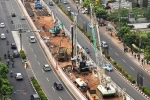Towards advanced Indonesia
This article has been translated by PwC Indonesia as part of our Indonesia Infrastructure News Service. PwC Indonesia has not checked the accuracy of, and accepts no responsibility for the content.
Investor Daily - Menuju Indonesia maju
16 August 2023
The ceremony to commemorate the 78th Independence Day anniversary of Indonesia that will be held at the Presidential Palace’s courtyard tomorrow on Thursday (17/8/2023) will be the 9th time that President Joko Widodo (Jokowi) has acted as the ceremony inspector. It means that President Jokowi only has around one year left to complete the various programmes left in his second administration. On 20 October next year, Indonesia will be led by a new president that will be determined by the elections in 2024.
In the last year of his first administration in May 2019, Jokowi launched Indonesia Vision 2045. The vision is directed to realise an advanced, fair, and prosperous Indonesia in the framework of the Unitary State of the Republic of Indonesia (NKRI). The vision has been reaffirmed through the launch of the 2025-2045 National Long-Term Development Plan (RPJPN) on 15 June 2023.
Currently, the title of the vision has been slightly changed to Golden Indonesia 2045 with the tagline Sovereign, Advanced, and Sustainable Nation. The vision is expanded into five main targets that provide imperative elements for development realisation.
The first target is to achieve a per capita income of around US$23,000 – US$30,300 that is equal to advanced countries to be one of the top 5 economies in the world. The target can be achieved by increasing the contribution of the gross domestic product (GDP) of the manufacturing industry from 18.25% to 28% and of the maritime industry from 7.6% to 15%. This realisation is expected to boost the number of people with middle income to around 80%.
The second target is to reduce the poverty rate to around 0.5%-0.8% to eventually achieve 0%, which will be followed by a significant decrease in the number of people who are prone to poverty. Hence, the income disparity ratio among citizens will also go down to around 0.290-0.320 from 0.381. The disparity among regions will also be lower as the gross regional product (PDRB) contribution of eastern regions has increased to 28.5%.
The third target is to enhance the role and the impact of Indonesia on the international world to reach rank 11 in the Global Power Index (GPI). The fourth target is to increase the competitiveness of human resources through education, training, work behaviour and ethos development, innovation technology and creativity mastery, as well as health improvement. It will be measured through the increase in the Human Capital Index (HCI) from 0.54 in 2020 to 0.73 in 2045.
The fifth and the last target is to realise an advanced Indonesia that has a strong commitment to carrying out sustainable and eco-friendly development in the green economy framework. It will mainly be reflected in the decline in the greenhouse gas emission intensity to 93.5% in 2045 and in the net zero emission realisation in 2060.
Several other indicators have also been set so that Indonesia can be an advanced country or at least match advanced countries in 2045. With an average economic growth of 7%, in 2045, Indonesia is set to realise a gross domestic product (GDP) of US$9.8 trillion (top 5 in the world) or a gross national income (GNI) per capita of US$30,000 (middle income class reaching 80%).
Meanwhile, the average investment growth reaches 6.8% per year (incremental capital out ratio/ICOR 4.6), while the contribution of the manufacturing industry to the GDP reaches 28% (with contribution to workforce reaching 25.2%). Currently, Indonesia’s ICOR reaches 7.6, which is far higher than Malaysia’s that reaches 4.4.
9 years of achievements
Several achievements have been realised in the last 10-20 years, which include the 9 years of President Joko Widodo’s administration. Among the achievements, one of the highlights is the massive infrastructure development. Between 2014-2022, infrastructure development has been meant to support connectivity, electricity, information, communication, and technology, reservoirs and irrigation channels, and basic facilities and infrastructure.
Achievements regarding infrastructure development include operational toll roads that extended by four times to 2,687 km in 2022 from 804 km in 2014 and public roads that extended by 32.41 thousand km to 549.16 thousand km in 2022 from 517.75 thousand km in 2014.
Next, power plants increased from 53 gigawatts in 2014 to 81.2 gigawatts in 2022. The capacity of dams surged from 6.39 billion cubic metres in 2014 to 16.96 billion cubic metres in 2022. Airports increased from 237 units in 2014 to 278 units in 2022. Meanwhile, ports increased from 1,655 units in 2014 to 3,157 units in 2022. All of the projects cost up to Rp2,779 trillion.
Amid the economic turmoil, Indonesia has also successfully decreased its poverty and unemployment rates significantly. The poverty rate reached 15.97% in 2005, and it even surged to 17.75% in 2016, but it declined to 9.22% in 2019. It went back up to 10.19% in 2020 due to the Covid-19 pandemic, but the poverty rate was supressed again to 9.57% in 2022.
It is related to the improvement of social security programmes, such as the social security and the manpower programmes that reduced the unemployment rate. The open unemployment rate was successfully supressed from 11.24% in 2005 to 5,23% in 2019. After it went up to 7.07% in 2020 due to the Covid-19 pandemic, the unemployment rate was successfully lowered again to 5.86% in 2022.
The poverty rate and the open unemployment rate are set to be reduced to 6.5%-7.5% and 5.0%-5.7% respectively in 2024. In line with the second target, in the 2025-2045 RPJPN, the poverty rate is set to reach around 0.5%-0.8% to achieve 0% and the unemployment rate is set to reach 4% in 2045.
Dozens of challenges
They can be a capital to achieve Golden Indonesia 2045. However, on the other hand, dozens of challenges are still blocking the way, including low productivity, science, technology, and innovation (iptekin), low research, early deindustrialisation, underutilised tourism, and suboptimal maritime economy.
Other challenges include micro, small, and medium enterprise (MSME) and small cooperative contributions, low infrastructure and digital literacy, unsustainable development, limited domestic integration, degrading human resource quality, suboptimal governance, weak legal certainty and law enforcement, suboptimal democracy, as well as disparity between Java and outside of Java.
Among the achievements, there are several setbacks that must be highlighted, such as the agriculture sector. The productivity of the agricultural sector continued to go down from Rp41.5 million per worker in 2010 to only Rp22.9 million per worker in 2022.
The low productivity of the agricultural sector is caused by the slow regeneration of farmers and fishermen, the lack of expertise of farmers and fishermen, and the limited adoption of technologies and financial access.
Besides that, it is also caused by the lack of a standardised process, the weak economic institutions for farmers and fishermen that are legal entities, and the decline in the capacity of farming lands.
The contribution of the manufacturing sector to the GDP continued to go down from 27.41% in 2005 to only 18.35% in 2022. The number of workers in the agricultural sector significantly decreased from 44% of the total workforce in 2005 to 28.6% in 2022. Workforce in the manufacturing sector slightly increased from 12.7% in 2005 to 14.2% in 2022.
In the last 20 years, the contribution of the manufacturing sector to the GDP has been going down to experience early deindustrialisation. It is caused by the manufacturing sector weakening (Dutch disease), the low productivity of the production factors, the limited ability to adopt technologies, research results, and innovations, the limited support from the industrial ecosystem outside of Java, and the high-cost economy due to logistics costs and interest rates.
Next Article: The trap of infrastructure development


















